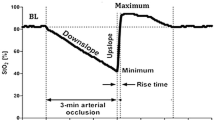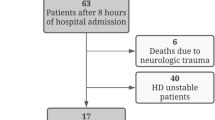Abstract
Introduction
We assessed tissue O2 saturation (StO2) and total hemoglobin (HbT) changes during a vascular occlusion test (VOT) as markers of O2 consumption and cardiovascular reserve.
Methods
Using the non-invasive InSpectra® near infrared spectrometer, we studied the effect of VOT to StO2 < 40% then release on thenar eminence StO2 and HbT in 15 normal volunteers (controls) and 10 trauma patients. We repeated the VOT four times in controls and twice in patients, with controls exercising during the last VOT, and correlated StO2 with HbT changes by linear regression analysis.
Results
StO2 started to decrease 3–28 s post-occlusion (latency) in controls and then decreased in a linear fashion (−0.18 ± 0.04% O2/s, mean ± SD), while post-occlusion StO2 recovery was rapid (5.20 ± 1.19% O2/s). Exercise decreased latency (0–5 s) and increased desaturation rate (−0.18 and −0.69% O2/s, P < 0.005) without altering recovery. Trauma patients showed similar StO2 desaturation rates, but slower recovery (5.20 ± 1.19 vs. 2.88 ± 1.71%/s, P < 0.0001). Repeated VOT gave similar recovery results within study groups. The hyperemic response was variable in both groups and, if present, was associated with an increased HbT. HbT pre- and post-VOT were significantly different within each subject. Although HbT slope of recovery correlated significantly with StO2 recovery in trauma patients (rho 0.76), it was not in controls.
Conclusions
One VOT defines StO2 deoxygenation and recovery. That StO2 and HbT recovery co-vary only in trauma patients suggests that pre-existing vasoconstriction was unmasked by the ischemic challenge consistent with increased sympathetic tone.



Similar content being viewed by others
References
Taylor JH, Mulier KE, Myers DE, Beilman GJ (2005) Use of near-infrared spectroscopy in early determination of irreversible hemorrhagic shock. J Trauma 58:1119–1125
Andrews P, Azoulay E, Antonelli M, Brochard L, Brun-Buisson C, de Backer D, Dobb G, Fagon JY, Gerlach H, Groeneveld J, Mancebo J, Metnitz P, Nava S, Pugin J, Pinsky M, Radermacher P, Richard C, Tasker R (2006) Year in review in intensive care medicine. 2005. I. Acute respiratory failure and acute lung injury, ventilation, hemodynamics, education, renal failure. Intensive Care Med 32:207–216
Andrews P, Azoulay E, Antonelli M, Brochard L, Brun-Buisson C, Dobb G, Fagon JY, Gerlach H, Groeneveld J, Mancebo J, Metnitz P, Nava S, Pugin J, Pinsky M, Radermacher P, Richard C, Tasker R (2006) Year in review in intensive care medicine, 2005. II. Infection and sepsis, ventilator-associated pneumonia, ethics, haematology and haemostasis, ICU organisation and scoring, brain injury. Intensive Care Med 32:380–390
Schriger DL, Baraff L (1988) Defining normal capillary refill: variation with age, sex, and temperature. Ann Emerg Med 17:932–935
Andrews P, Azoulay E, Antonelli M, Brochard L, Brun-Buisson C, De Backer D, Dobb G, Fagon JY, Gerlach H, Groeneveld J, Macrae D, Mancebo J, Metnitz P, Nava S, Pugin J, Pinsky M, Radermacher P, Richard C (2007) Year in review in Intensive care medicine, 2006. I. Experimental studies. Clinical studies: brain injury, renal failure and endocrinology. Intensive Care Med 33:49–57
Andrews P, Azoulay E, Antonelli M, Brochard L, Brun-Buisson C, Dobb G, Fagon JY, Gerlach H, Groeneveld J, Mancebo J, Metnitz P, Nava S, Pugin J, Pinsky M, Radermacher P, Richard C, Tasker R (2006) Year in review in intensive care medicine, 2005. III. Nutrition, pediatric and neonatal critical care, and experimental. Intensive Care Med 32:490–500
Benaron DA, Parachikov IH, Friedland S, Soetikno R, Brock-Utne J, van der Starre PJ, Nezhat C, Terris MK, Maxim PG, Carson JJ, Razavi MK, Gladstone HB, Fincher EF, Hsu CP, Clark FL, Cheong WF, Duckworth JL, Stevenson DK (2004) Continuous, noninvasive, and localized microvascular tissue oximetry using visible light spectroscopy. Anesthesiology 100:1469–1475
Andrews P, Azoulay E, Antonelli M, Brochard L, Brun-Buisson C, De Backer D, Dobb G, Fagon JY, Gerlach H, Groeneveld J, Macrae D, Mancebo J, Metnitz P, Nava S, Pugin J, Pinsky M, Radermacher P, Richard C (2007) Year in Review in intensive care medicine, 2006. III. Circulation, ethics, cancer, outcome, education, nutrition, and pediatric and neonatal critical care. Intensive Care Med 33:414–422
Andrews P, Azoulay E, Antonelli M, Brochard L, Brun-Buisson C, De Backer D, Dobb G, Fagon JY, Gerlach H, Groeneveld J, Macrae D, Mancebo J, Metnitz P, Nava S, Pugin J, Pinsky M, Radermacher P, Richard C (2007) Year in review in intensive care medicine, 2006. II. Infections and sepsis, haemodynamics, elderly, invasive and noninvasive mechanical ventilation, weaning, ARDS. Intensive Care Med 33:214–229
Myers DE, Anderson LD, Seifert RP, Ortner JP, Cooper CE, Beilman GJ, Mowlem JD (2005) Noninvasive method for measuring local hemoglobin oxygen saturation in tissue using wide gap second derivative near-infrared spectroscopy. J Biomed Opt 10:034017
Boushel R, Pott F, Madsen P, Radegran G, Nowak M, Quistorff B, Secher N (1998) Muscle metabolism from near infrared spectroscopy during rhythmic handgrip in humans. Eur J Applied Physiol Occup Physiol 79:41–48
Cheatle TR, Potter LA, Cope M, Delpy DT, Coleridge Smith PD, Scurr JH (1991) Near-infrared spectroscopy in peripheral vascular disease. Br J Surg 78:405–408
Colier WN, Meeuwsen IB, Degens H, Oeseburg B (1995) Determination of oxygen consumption in muscle during exercise using near infrared spectroscopy. Acta anaesthesiol Scand 107:151–155
De Blasi RA, Cope M, Elwell C, Safoue F, Ferrari M (1993) Noninvasive measurement of human forearm oxygen consumption by near infrared spectroscopy. Eur J Appl Physiol Occup Physiol 67:20–25
De Blasi RA, Cope M, Ferrari M (1992) Oxygen consumption of human skeletal muscle by near infrared spectroscopy during tourniquet-induced ischemia in maximal voluntary contraction. Adv Exp Med Biol 317:771–777
Hamaoka T, Iwane H, Shimomitsu T, Katsumura T, Murase N, Nishio S, Osada T, Kurosawa Y, Chance B (1996) Noninvasive measures of oxidative metabolism on working human muscles by near-infrared spectroscopy. J Appl Physiol 81:1410–1417
Homma S, Eda H, Ogasawara S, Kagaya A (1996) Near-infrared estimation of O2 supply and consumption in forearm muscles working at varying intensity. J Appl Physiol 80:1279–1284
Skarda DE, Mulier KE, Myers DE, Taylor JH, Beilman GJ (2007) Dynamic near-infrared spectroscopy measurements in patients with severe sepsis. Shock (Augusta, Ga.) 27:348–353
Boushel R, Langberg H, Olesen J, Gonzales-Alonzo J, Bulow J, Kjaer M (2001) Monitoring tissue oxygen availability with near infrared spectroscopy (NIRS) in health and disease. Scand J Med Sci Sports 11:213–222
Creteur J, Carollo T, Soldati G, Buchele G, De Backer D, Vincent JL (2007) The prognostic value of muscle StO2 in septic patients. Intensive Care Med 33:1549–1556
Chow CC, Clermont G, Kumar R, Lagoa C, Tawadrous Z, Gallo D, Betten B, Bartels J, Constantine G, Fink MP, Billiar TR, Vodovotz Y (2005) The acute inflammatory response in diverse shock states. Shock (Augusta, Ga.) 24:74–84
Habler O (2005) Cardiac high-risk patients: from “permissive” to “deliberate” anemia. Crit Care Med 33:2434–2435
Jamnicki M, Kocian R, van der Linden P, Zaugg M, Spahn DR (2003) Acute normovolemic hemodilution: physiology, limitations, and clinical use. J Cardiothorac Vasc Anesth 17:747–754
Lieberman JA, Weiskopf RB, Kelley SD, Feiner J, Noorani M, Leung J, Toy P, Viele M (2000) Critical oxygen delivery in conscious humans is less than 7.3 ml O2 × kg(−1) × min(−1). Anesthesiology 92:407–413
Siafaka A, Angelopoulos E, Kritikos K, Poriazi M, Basios N, Gerovasili V, Andreou A, Roussos C, Nanas S (2007) Acute effects of smoking on skeletal muscle microcirculation monitored by near-infrared spectroscopy. Chest 131:1479–1485
Acknowledgment
This research was supported in part by NHLBI grants HL67181 and HL76157.
Author information
Authors and Affiliations
Corresponding author
Additional information
This article is discussed in the editorial available at doi:10.1007/s00134-008-1146-0.
Electronic supplementary material
Below is the link to the electronic supplementary material.
134_2008_1145_MOESM2_ESM.doc
Table E1 Comparison of deoxygenation and recovery slopes between initial measurement and 6 months after in healthy volunteers (DOC 33 kb)
Rights and permissions
About this article
Cite this article
Gómez, H., Torres, A., Polanco, P. et al. Use of non-invasive NIRS during a vascular occlusion test to assess dynamic tissue O2 saturation response. Intensive Care Med 34, 1600–1607 (2008). https://doi.org/10.1007/s00134-008-1145-1
Received:
Accepted:
Published:
Issue Date:
DOI: https://doi.org/10.1007/s00134-008-1145-1




